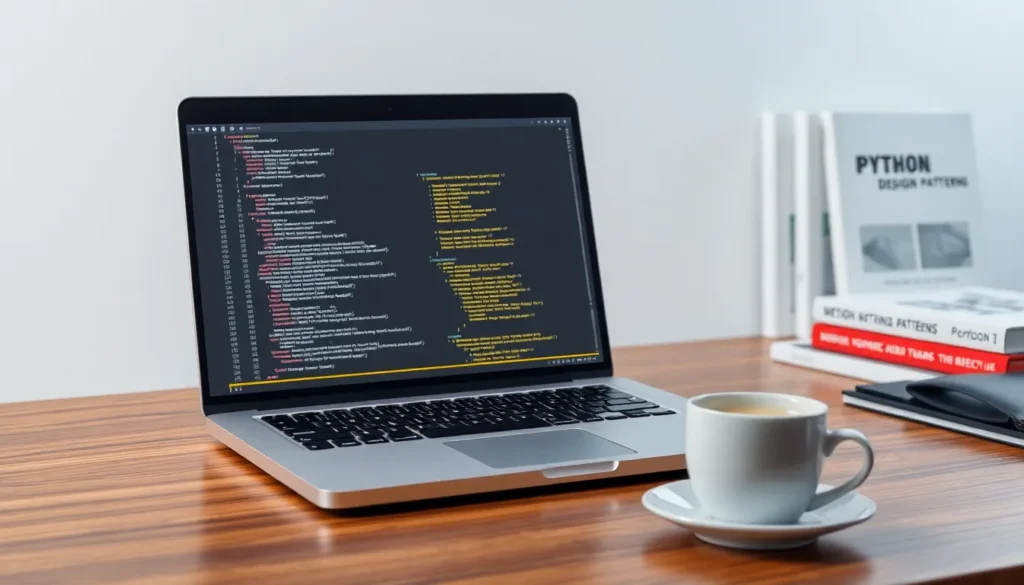In the world of coding, Python stands out like a well-trained puppy at a dog park—adorable, versatile, and just a bit unpredictable if not properly trained. Mastering Python is one thing, but using it effectively is a whole different ballgame. That’s where best practices come in, turning your code from a tangled mess into a smooth-running machine that even your non-techy friends would admire.
Table of Contents
ToggleOverview of Python Best Practices
Python best practices encompass guidelines that enhance code clarity, maintainability, and performance. Adhering to these practices fosters a cleaner, more efficient coding environment.
One essential practice involves using meaningful variable names. Code readability improves significantly when variables clearly describe their purpose. Rather than using generic names, choose descriptive ones.
Consistent formatting is crucial for collaboration. PEP 8, the style guide for Python, provides standards for indentation, line length, and spacing. Following PEP 8 helps ensure uniformity across projects.
Documentation also plays a vital role. Including docstrings for functions and classes clearly explains their purpose and usage. Proper documentation aids both current and future developers in understanding the code.
Using version control systems, like Git, facilitates tracking changes within projects. This approach encourages collaborative development, allowing multiple developers to work simultaneously without conflicts.
Testing code regularly leads to high-quality applications. Implementing unit tests verifies that individual components function as intended. Comprehensive test coverage identifies bugs early, minimizing complications during deployment.
Emphasizing code reuse through modular design enhances efficiency. Developers should create small, focused functions that can be reused across different programs. This strategy reduces redundancy and improves maintainability.
Selecting the right data structures optimizes performance. Familiarity with Python’s built-in structures—like lists, tuples, and dictionaries—allows developers to leverage those that suit specific tasks best.
Utilizing virtual environments is essential for managing dependencies. They can isolate project requirements and prevent version conflicts across multiple projects. Setting up a virtual environment simplifies package management.
Emphasizing these Python best practices leads to better coding habits, ultimately improving both the developer’s skill and the product’s quality.
Coding Standards

Coding standards maintain consistency, readability, and maintainability in Python. Following established conventions simplifies collaboration and improves overall coding quality.
PEP 8 Guidelines
PEP 8 represents the style guide for Python code, promoting clarity and uniformity. It specifies naming conventions for variables, functions, and classes, ensuring developers adhere to common principles. Indentation levels should remain consistent, while line length typically caps at 79 characters. Additionally, whitespace usage around operators and after commas requires attention. By adhering to PEP 8, developers create visually appealing and understandable code that others can read easily.
Naming Conventions
Naming conventions enhance code readability and comprehension. Variables should utilize lowercase letters and underscores (e.g., my_variable). Functions adopt a similar format, while class names generally employ the CapWords convention (e.g., MyClass). Constants, on the other hand, consist of all uppercase letters with underscores separating words (e.g., MY_CONSTANT). Clear and descriptive names promote self-documenting code, reducing the need for excessive comments. Following these conventions aids in conveying the intent of the code effectively.
Code Structure
Effective code structure leads to improved readability and maintainability. Implementing best practices for organizing files, directories, and modular programming proves essential in Python development.
Organizing Files and Directories
Organized files and directories enhance project structure. Create a clear hierarchy that separates code, documentation, and tests. Use appropriate naming conventions for folders to describe their contents accurately. For Python projects, utilizing a top-level directory with subdirectories like src for source code, tests for unit tests, and docs for documentation assists in easy navigation. Implementing a README file at the root level provides essential information regarding project usage. Maintaining this order simplifies collaboration across teams and introduces clarity, ultimately making project management more effective.
Modular Programming
Modular programming encourages code reuse and simplifies testing. Break code into small, independent modules that perform specific tasks. Each module should contain related functions or classes. This structure enables easy updates without affecting other parts of the application. Adopting this approach minimizes redundancy, as common functionalities reside in a single module instead of being duplicated across the codebase. Furthermore, unit tests can target individual modules, fostering a more efficient testing and debugging process. Emphasizing modularity contributes positively to code quality and development speed.
Documentation Practices
Documentation practices play a crucial role in ensuring code clarity and maintainability. Effective documentation aids collaboration and enhances understanding of the codebase.
Docstrings and Comments
Docstrings serve as in-code documentation for modules, classes, and functions. They describe purpose, parameters, and return values, making it easier for others to understand functionality. Comments complement docstrings by explaining complex logic or decisions. They clarify intent and provide insights, ensuring code remains accessible. Keeping comments concise and relevant helps prevent clutter, allowing readers to focus on essential aspects. Consistent formatting of both docstrings and comments enhances readability and professionalism. Following PEP 257 for docstring conventions ensures a standard approach, aligning with best practices in Python development.
ReadMe Files
ReadMe files provide vital information about projects, serving as entry points for users and contributors. Key components include project title, description, installation instructions, and usage guidelines. Providing examples enhances comprehension and demonstrates practical implementation. Including a section for contributions encourages community involvement, while licensing information clarifies usage rights. A well-structured ReadMe file minimizes confusion and fosters a smoother onboarding experience. Prioritizing clarity and completeness in these files ensures that both new and experienced users can navigate the project with ease.
Testing and Debugging
Testing and debugging are essential components of the development process. These practices ensure code reliability and enhance overall performance.
Unit Testing
Unit testing involves checking individual components of the code for correct functionality. It allows developers to identify bugs early in the development cycle, saving time and resources. Python’s built-in unittest framework streamlines this process by providing tools for writing and executing tests. Developers create test cases that cover various scenarios and edge cases, ensuring comprehensive coverage of the codebase. Running tests frequently helps maintain high standards throughout the development. As a result, robust applications emerge from regular unit testing, leading to increased confidence in code quality.
Debugging Techniques
Debugging techniques identify and resolve errors within the code. Various strategies exist to facilitate the debugging process. Using print statements provides straightforward insight into variable values at critical points. Applying Python’s built-in pdb module allows for step-by-step execution, enabling a closer examination of code behavior. Logging modules capture information during runtime, making it easier to track down issues later. Moreover, utilizing integrated development environments (IDEs) with debugging tools enhances visibility into the program’s execution flow. Effective debugging practices lead developers toward efficient problem resolution and minimize disruptions in the coding process.
Performance Optimization
Performance optimization plays a vital role in enhancing the efficiency of Python applications. Implementing specific strategies can significantly improve both speed and resource usage.
Efficient Algorithms
Choosing efficient algorithms is essential for maximizing performance. Algorithms such as binary search drastically reduce the time complexity from O(n) to O(log n) when searching in a sorted list. Employing search and sorting algorithms, like quicksort, ensures optimal performance for larger datasets. Evaluating the trade-offs between time and space complexity enables developers to select the most suitable algorithm for specific problems. Utilizing built-in functions, which are often optimized in Python’s standard library, can also enhance performance significantly.
Memory Management
Effective memory management is crucial for optimizing Python applications. Utilizing generators instead of lists can drastically reduce memory consumption, especially when dealing with large datasets. Implementing proper data structures ensures efficient memory usage, such as using sets for membership tests rather than lists. Cleaning up references to unused objects allows Python’s garbage collector to reclaim memory efficiently. Profiling memory usage with tools like memory_profiler provides insights into potential leaks and areas for improvement, leading to more resource-efficient programs.
Embracing Python best practices is essential for any developer aiming to write efficient and maintainable code. By focusing on clarity through meaningful naming conventions and adhering to PEP 8 guidelines, programmers can create self-documenting code that speaks for itself.
The integration of documentation practices and effective code structure not only enhances readability but also fosters collaboration among teams. Regular testing and debugging ensure that applications remain reliable and high-performing.
Ultimately, adopting these best practices leads to improved coding habits and a higher quality final product, setting developers on a path toward success in their Python programming journey.










